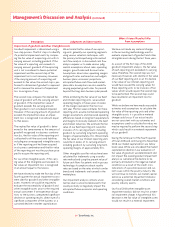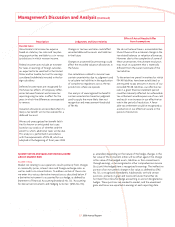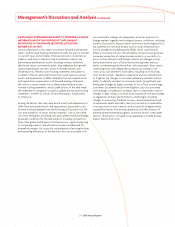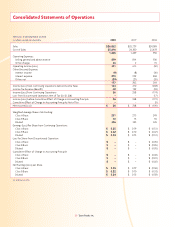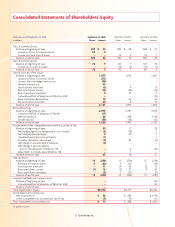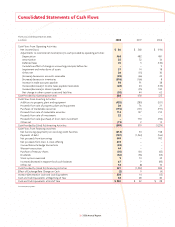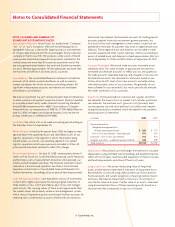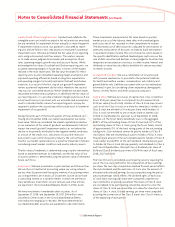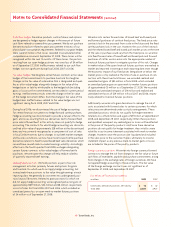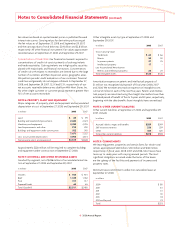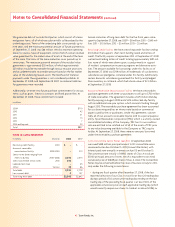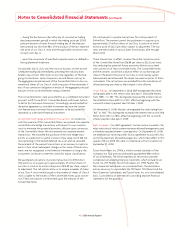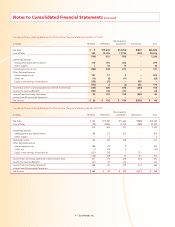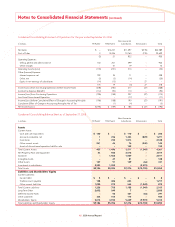Tyson Foods 2008 Annual Report Download - page 38
Download and view the complete annual report
Please find page 38 of the 2008 Tyson Foods annual report below. You can navigate through the pages in the report by either clicking on the pages listed below, or by using the keyword search tool below to find specific information within the annual report.
36 Tyson Foods, Inc.
Notes to Consolidated Financial Statements (continued)
Financial Instruments: We purchase certain commodities, such as
grains and livestock in the course of normal operations. As part of
our commodity risk management activities, we use derivative fi nan-
cial instruments, primarily futures and options, to reduce our exposure
to various market risks related to these purchases, as well as to changes
in foreign currency exchange rates. Contract terms of a fi nancial
instrument qualifying as a hedge instrument closely mirror those of
the hedged item, providing a high degree of risk reduction and cor-
relation. Contracts designated and highly effective at meeting risk
reduction and correlation criteria are recorded using hedge account-
ing. If a derivative instrument is accounted for as a hedge, changes
in the fair value of the instrument will be offset either against the
change in fair value of the hedged assets, liabilities or fi rm commit-
ments through earnings or recognized in other comprehensive income
(loss) until the hedged item is recognized in earnings. The ineffective
portion of an instrument’s change in fair value is immediately recog-
nized in earnings as a component of cost of sales. Instruments we
hold as part of our risk management activities that do not meet the
criteria for hedge accounting are marked to fair value with unreal-
ized gains or losses reported currently in earnings. Changes in market
value of derivatives used in our risk management activities relating to
forward sales contracts are recorded in sales. Changes in market value
of derivatives used in our risk management activities surrounding
inventories on hand or anticipated purchases of inventories or
supplies are recorded in cost of sales. We generally do not hedge
anticipated transactions beyond 12 months.
Revenue Recognition: We recognize revenue when title and risk of
loss are transferred to customers, which is generally on delivery
based on terms of sale. Revenue is recognized as the net amount
estimated to be received after deducting estimated amounts for
discounts, trade allowances and product terms.
Litigation Reserves: There are a variety of legal proceedings pending
or threatened against us. Accruals are recorded when it is probable
a liability has been incurred and the amount of the liability can be
reasonably estimated based on current law, progress of each case,
opinions and views of legal counsel and other advisers, our experi-
ence in similar matters and intended response to the litigation. These
amounts, which are not discounted and are exclusive of claims against
third parties, are adjusted periodically as assessment efforts progress
or additional information becomes available. We expense amounts
for administering or litigating claims as incurred. Accruals for legal
proceedings are included in Other current liabilities in the Consoli-
dated Balance Sheets.
Freight Expense: Freight expense associated with products shipped to
customers is recognized in cost of sales.
Advertising and Promotion Expenses: Advertising and promotion
expenses are charged to operations in the period incurred. Customer
incentive and trade promotion activities are recorded as a reduction
to sales based on amounts estimated as being due to customers,
based primarily on historical utilization and redemption rates, while
other advertising and promotional activities are recorded as selling,
general and administrative expenses. Advertising and promotion
expenses for fi scal years 2008, 2007 and 2006 were $495 million,
$467 million and $493 million, respectively.
Use of Estimates: The consolidated fi nancial statements are prepared
in conformity with accounting principles generally accepted in the
United States, which require us to make estimates and assumptions
that affect the amounts reported in the consolidated fi nancial state-
ments and accompanying notes. Actual results could differ from
those estimates.
Recently Issued Accounting Pronouncements: In September 2006,
the FASB issued Statement of Financial Accounting Standards No. 157,
“Fair Value Measurements” (SFAS No. 157). SFAS No. 157 provides
guidance for using fair value to measure assets and liabilities. This
standard also responds to investors’ requests for expanded infor-
mation about the extent to which companies measure assets and
liabilities at fair value, the information used to measure fair value and
the effect of fair value measurements on earnings. SFAS No. 157 applies
whenever other standards require (or permit) assets or liabilities to
be measured at fair value. Beginning September 28, 2008, we partially
applied SFAS No. 157 as allowed by FASB Staff Position (FSP) 157-2,
which delayed the effective date of SFAS No. 157 for nonfi nancial
assets and liabilities. As of September 28, 2008, we have applied
the provisions of SFAS No. 157 to our fi nancial instruments and the
impact was not material. Under FSP 157-2, we will be required to
apply SFAS No. 157 to our nonfi nancial assets and liabilities at the
beginning of fi scal 2010. We are currently reviewing the applicability
of SFAS No. 157 to our nonfi nancial assets and liabilities as well as
the potential impact on our consolidated fi nancial statements.
In February 2007, the FASB issued Statement of Financial Accounting
Standards No. 159, “The Fair Value Option for Financial Assets and
Financial Liabilities, including an amendment of FASB Statement
No. 115” (SFAS No. 159). This statement provides companies with an
option to report selected fi nancial assets and liabilities fi rm commit-
ments, and nonfi nancial warranty and insurance contracts at fair value
on a contract-by-contract basis, with changes in fair value recognized
in earnings each reporting period. At September 28, 2008, we did not
elect the fair value option under SFAS No. 159 and therefore there
was no impact to our consolidated fi nancial statements.
In December 2007, the FASB issued Statement of Financial Accounting
Standards No. 160, “Noncontrolling Interests in Consolidated Finan-
cial Statements” (SFAS No. 160). SFAS No. 160 amends Accounting
Research Bulletin No. 51, “Consolidated Financial Statements” to
establish accounting and reporting standards for a noncontrolling
interest in a subsidiary and for the deconsolidation of a subsidiary.
This statement clarifi es that a noncontrolling interest in a subsidiary
is an ownership interest in the consolidated entity and should be
reported as equity in the consolidated fi nancial statements, rather


